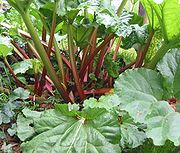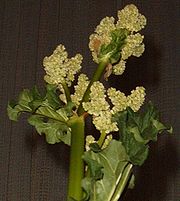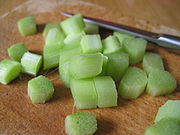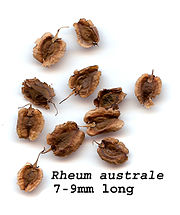
Rhubarb
Background to the schools Wikipedia
Arranging a Wikipedia selection for schools in the developing world without internet was an initiative by SOS Children. Sponsor a child to make a real difference.
| Rhubarb | |
|---|---|
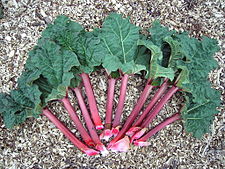 |
|
| Scientific classification | |
| Kingdom: | Plantae |
| Division: | Magnoliophyta |
| Class: | Magnoliopsida |
| Order: | Caryophyllales |
| Family: | Polygonaceae |
| Genus: | Rheum L. |
| Species | |
|
About 60, including:
|
|
Rheum is a genus of perennial plants that grow from thick short rhizomes. The genus is in the family Polygonaceae, and includes the vegetable rhubarb (Rheum rhabarbarum or Rheum x hybridum.) The plants have large leaves that are somewhat triangular shaped with long fleshy petioles. The flowers are small, greenish-white to rose-red, and grouped in large compound leafy inflorescences. A number of varieties of rhubarb have been domesticated both as medicinal plants and for human consumption. While the leaves are toxic, the stalks are used in pies and other foods for their tart flavor.
Species
The genus is represented by about 60 extant species. Among species found in the wild, those most commonly used in cooking are the Garden Rhubarb (R. rhabarbarum) and R. rhaponticum, which, though a true rhubarb, bears the common name False Rhubarb. The many varieties of cultivated rhubarb more usually grown for eating are recognised as Rheum x hybridum in the Royal Horticultural Societies list of recognised plant names. The drug rheum is prepared from the rhizomes and roots of another species, R. officinale or Medicinal Rhubarb. This species is also native to Asia, as is the Turkey Rhubarb (R. palmatum). Another species, the Sikkim Rhubarb (R. nobile), is limited to the Himalayas.
Rheum species have been recorded as larval food plants for some Lepidoptera species including Brown-tail, Buff Ermine, Cabbage Moth, Large Yellow Underwing, The Nutmeg, Setaceous Hebrew Character and Turnip Moth.
Description
Rheum species are herbaceous perennials with hermaphrodite flowers, consisting of a colored perianth, composed of six to nine segments, arranged in two rows. The flowers have nine stamina inserted on the torus at the base of the peranthium, they are free or subconnatent at their base. The ovary is simple and triangular shaped with three styles. The fruits are a three-sided caryopsis with winged sides, the seeds are albuminous and have straight embryos.
Cultivation and consumption
The plant is indigenous to Asia, and many suggest that it was often used by the Mongolians; particularly, the Tatars tribes of the Gobi Desert. The plant has grown wild along the banks of the River Volga for centuries; it may have been brought there by Eurasian tribes, such as the Scythians, Huns, Magyars or Mongols. The term rhubarb is a combination of the Greek rha and barbarum; rha being a term that referred both to the plant and to the River Volga. Varieties of rhubarb have a long history as medicinal plants in traditional Chinese medicine, but the use of rhubarb as food is a relatively recent innovation, first recorded in 17th century England, after affordable sugar became available to common people, and reaching a peak between the 20th century's two world wars. Rhubarb first came to America in the 1820s, entering the country in Maine and Massachusetts and moving westwards with the settlers.
Rhubarb is now grown in many areas and thanks to greenhouse production is available throughout much of the year. Grown primarily for its fleshy petioles, commonly known as rhubarb sticks or stalks. In temperate climates rhubarb is one of the first food plants to be ready for harvest, usually in mid to late spring (April/May in the Northern Hemisphere, October/November in the Southern Hemisphere), and the season for field-grown plants lasts until September. In the northwestern states of Oregon and Washington, there are typically two harvests: one from late April to May and another from late June and into July. Rhubarb is ready to be consumed as soon as it is harvested, and freshly cut stalks will be firm and glossy.
The colour of the rhubarb stalks can vary from the commonly associated deep red, through speckled pink, to simply green. The colour results from the presence of anthocyanins, and varies according to both rhubarb variety and production technique. The colour is not related to its suitability for cooking: The green-stalked rhubarb is more robust and has a higher yield, and the red-coloured stalks are more popular with consumers.
The stalks, which are petioles, can be cooked in a variety of ways. Stewed, they yield a tart sauce that can be eaten with sugar and stewed fruit or used as filling for pies (see rhubarb pie), tarts, and crumbles. This common use has led to the slang term for rhubarb, "pie plant". Cooked with strawberries or apples as a sweetener, or with stem or root ginger, rhubarb makes excellent jam. It can also be used to make wine and as an ingredient in baked goods.
In former days, a common and affordable sweet for children in parts of the United Kingdom and Sweden was a tender stick of rhubarb, dipped in sugar. In the UK the first rhubarb of the year is grown by candlelight in dark sheds dotted around the noted " Rhubarb Triangle" of Wakefield, Leeds and Morley, a practice that produces a sweeter, more tender stalk.
In warm climates, rhubarb will grow all year round, but in colder climates the parts of the plant above the ground disappear completely during winter, and begin to grow again from the root in early spring. It can be forced, that is, encouraged to grow early, by raising the local temperature. This is commonly done by placing an upturned bucket over the shoots as they come up. Because rhubarb is a seasonal plant, obtaining fresh rhubarb out of season is difficult, especially in the UK, and it may be a sign of someone's social stratification if they have fresh rhubarb out of season.
Rhubarb can successfully be planted in containers, so long as the container is large enough to accommodate a season's growth.
Rhubarb is used as a strong laxative and for its astringent effect on the mucous membranes of the mouth and the nasal cavity.
Toxic effects
Rhubarb leaves contain poisonous substances. Rhubarb leaves contain oxalic acid, a corrosive and nephrotoxic acid that is present in many plants. The LD50 (median lethal dose) for pure oxalic acid is predicted to be about 375 mg/kg body weight, or about 25 g for a 65 kg (~140 lb) human. While the oxalic acid content of rhubarb leaves can vary, a typical value is about 0.5%, so a rather unlikely five kilograms of the extremely sour leaves would have to be consumed to reach an LD50 dose of oxalic acid. However, the leaves are believed to also contain an additional, unidentified toxin. In the petioles, the amount of oxalic acid is much lower, only about 2-2.5% of the total acidity, especially when harvested before mid-June (in the northern hemisphere), but it is still enough to cause slightly rough teeth.
The roots have been used as strong laxative for over 5,000 years. The roots and stems are rich in anthraquinones, such as emodin and rhein. These substances are cathartic and laxative, which explains the sporadic abuse of Rhubarb as a slimming agent. Anthraquinones are yellow or orange and may colour the urine.
Other uses of the word
It is or was common for a crowd of extras in acting to shout the word "rhubarb" repeatedly and out of step with each other, to cause the effect of general hubbub. As a result, the word "rhubarb" sometimes is used to mean "length of superfluous text in speaking or writing", or a general term to refer to irrelevant chatter by chorus or extra actors. The American equivalent is walla.
Possibly from this usage, possibly from a variant on " rube", or perhaps some of both, the word also denotes a loud argument. The term has been most commonly used in baseball.
The term "rhubarb" as it relates to baseball is an antiquated reference to a fight amongst many players. The iconic bench-clearing brawl is known as a "rhubarb".
In the 1989 film Batman, The Joker ( Jack Nicholson) tells Bruce Wayne ( Michael Keaton) to "never rub another man's rhubarb". The term was used as a threat to Bruce Wayne warning him to leave both men's love interest Vicki Vale ( Kim Basinger) alone.
In the 1951 film adaptation of the Pulitzer Prize winning play by Tennessee Williams, A Streetcar Named Desire, Stanley ( Marlon Brando) gets into a ruckus at the bowling alley. His wife Stella (Kim Hunter) points him out to her sister Blanch (Vivien Leigh) and says, "(he's) the one that's making all the rhubarb", to describe him as the person at the centre of, or instigator of, the disruption.
The phrase "out in the rhubarb patch" can be used to describe a place being in the far reaches of an area. Rhubarb is usually grown at the outer edges of the garden in the less desirable and unkept area. Wheras the leaves and roots are poisonous, the stem is not. The term also refers to a 1954 book by Red Barber and Barney Stein, The Rhubarb Patch: The Story of the Modern Brooklyn Dodgers in which "Rhubarb Patch" was used in both its baseball and more general connotations to describe Ebbets Field, the home of the Brooklyn Dodgers.
In Canada, the phrase "putting it in the rhubarb" describes driving a vehicle off the road, possibly into roadside vegetation.
"Donkey Rhubarb" refers to Japanese knotweed and is also the name of an EP by Aphex Twin
